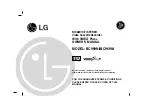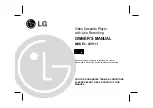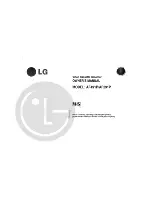
-
6
-
Model No.: VCR-S207
Version: 1.0
1. PRECAUTIONS
1. Be sure that all of the built-in protective devices are replaced. Restore any missing
protective shields.
2. When reinstalling the chassis and its assemblies, be sure to restore all protective devices,
including: control knobs and compartment covers.
3. Make sure that there are no cabinet openings through which people--particularly children
--might insert fingers and contact dangerous voltages. Such openings include the spacing
between the picture tube and the cabinet mask, excessively wide cabinet ventilation slots,
and improperly fitted back covers.
If the measured resistance is less than 1.0 megohm or greater than 5.2 megohms, an
abnormality exists that must be corrected before the unit is returned to the customer.
4 Leakage Current Hot Check (See Fig. 1-1):
Warning : Do not use an isolation transformer during this test. Use a leakage current tester
or a metering system that complies with American National Standards Institute (ANSI
C101.1, Leakage Current for Appliances), and Underwriters Laboratories (UL Publication
UL1410, 59.7).
5 With the unit completely reassembled, plug the AC line cord directly the power outlet. With
the unit’s AC switch first in the ON position and then OFF, measure the current between a
known earth ground (metal water pipe, conduit, etc.) and all exposed metal parts, including:
antennas, handle brackets, metal cabinets, screw heads and control shafts. The current
measured should not exceed 0.5 milliamp. Reverse the power-plug prongs in the AC outlet
and repeat the test.
6 X-ray
Limits:
The picture tube is designed to prohibit X-ray emissions. To ensure continued X-ray
protection, replace the picture tube only with one that is the same type as the original.
7 Antenna Cold Check:
With the unit’s AC plug disconnected from the AC source, connect an electrical jumper
across the two AC prongs. Connect one lead of the ohmmeter to an AC prong. Connect the
other lead to the coaxial connector.
8 High Voltage Limit:
High voltage must be measured each time servicing is done on the B+, horizontal deflection
or high voltage circuits. Heed the high voltage limits. These include the X-ray protection
Specifications Label, and the Product Safety and X-ray Warning Note on the service data
schematic.
9. Some semiconductor (“solid state”) devices are easily damaged by static electricity. Such
components are called Electrostatically Sensitive Devices (ESDs); examples include
integrated circuits and some field-effect transistors. The following techniques will reduce
the occurrence of component damage caused by static electricity.
10. Immediately before handling any semiconductor components or assemblies, drain the
electrostatic charge from your body by touching a known earth ground. Alternatively, wear
a discharging Wrist-strap device. (Be sure to remove it prior to applying power--this is an
electric shock precaution.)
Summary of Contents for VCR-S207
Page 1: ...Video Cassette Recorder Service Manual...
Page 2: ...2 Model No VCR S207 Version 1 0 MODEL VCR S207...
Page 5: ...5 Model No VCR S207 Version 1 0...
Page 10: ...10 Model No VCR S207 Version 1 0 2 1 1 Location of adjustment button of remote control...
Page 32: ...5 BLOCK DIAGRAM 32...
Page 33: ...6 SCHEMANTIC DIAGRAMS 33...
Page 34: ...6 1 S M P S 34...
Page 35: ...6 2 Power Drive 35...
Page 36: ...6 3 System Control Servo Display 36...
Page 37: ...6 4 Audio Video 37...
Page 38: ...6 5 TM 38...
Page 39: ...6 6 Input Output 39...
Page 40: ...6 7 Sub 40...







































